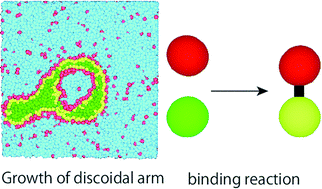Morphological changes of amphiphilic molecular assemblies induced by chemical reactions
Abstract
Shape transformations of amphiphilic molecular assemblies induced by chemical reactions are studied using coarse-grained molecular simulations. A binding reaction between hydrophilic and hydrophobic molecules is considered. It is found that the reaction induces transformation of an oil droplet to a tubular vesicle via bicelles and vesicles with discoidal arms. The discoidal arms close into vesicles, which are subsequently fused into the tubular vesicle. Under the chemical reaction, the bicelle-to-vesicle transition occurs at smaller sizes than in the absence of the hydrophobic molecules. It is revealed that the enhancement of this transition is due to embedded hydrophobic particles that reduce the membrane bending rigidity.


 Please wait while we load your content...
Please wait while we load your content...